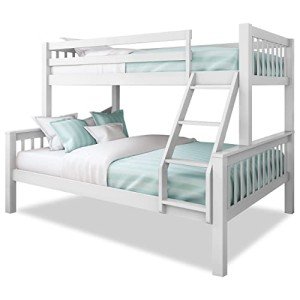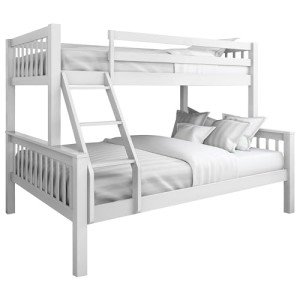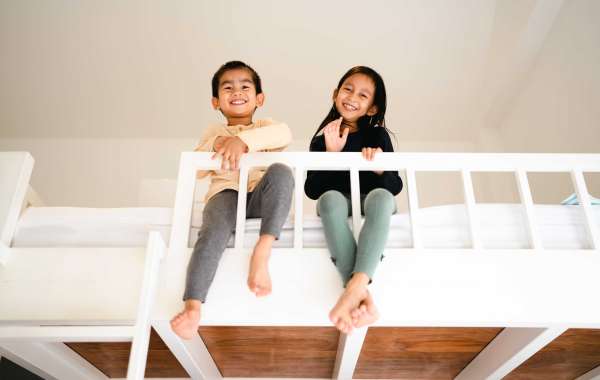
In recent years, 3-way bunk beds have emerged as a popular choice for families and individuals who wish to maximize their space without sacrificing comfort. These beds not only provide sleeping arrangements for multiple people but also contribute to the aesthetic appeal of a room. This guide explores the benefits, designs, and considerations of 3-way bunk beds, along with frequently asked questions to help readers make informed choices.
Understanding 3-Way Bunk Beds
A 3-way bunk bed is a versatile bedding solution that can typically be arranged in three different configurations: as a standard bunk bed, as two separate twin beds, and sometimes, with the option to add a trundle bed. This flexibility makes them ideal for children’s rooms, guest rooms, or multi-purpose spaces.
Key Features
| Feature | Description |
|---|---|
| Space-Saving Design | 3-way bunk beds utilize vertical space, making them ideal for smaller rooms. |
| Convertible Options | They can transition between multiple bed formats, including twin, full, and trundle configurations. |
| Durable Materials | Often made from solid wood or metal, ensuring long-lasting use and stability. |
| Safety Features | Equipped with guardrails and ladders for added safety, especially for young children. |
| Stylish Aesthetics | Available in various designs and finishes, complementing any room decor. |
Benefits of 3-Way Bunk Beds
Choosing a 3-way bunk bed can provide numerous advantages for families looking to optimize their living spaces. Here are some primary benefits:
- Space Efficiency: By stacking beds, you create more floor space for other activities or furniture.
- Versatility: The ability to rearrange the bed for different uses means it can grow with the needs of the household.
- Cost-Effectiveness: Instead of purchasing multiple beds, a Double Single Bunk Bed 3-way bunk bed can accommodate several guests or family members, saving money in the long term.
- Fun Factor: For kids, having a bunk bed can turn sleeping into a fun adventure, fostering creativity and playfulness.
- Style Options: Available in various styles, colors, and finishes to match any existing room decor.
Design Considerations
When selecting a 3-way bunk bed, it's important to consider the following factors:
Room Size: Ensure that the bunk bed fits comfortably in the allocated space. Measure the dimensions of the room, accounting for ceiling height to provide adequate headroom.
Material: Choose between wood, metal, or a combination of both. Wood lends a classic style, while metal often provides a more modern look.
Storage Options: Some models come with built-in drawers or shelves, providing extra storage without taking up additional space.
Child Safety: If the bed will be used by young children, prioritize models that feature safety rails and a sturdy ladder.
Style Preferences: Consider the design theme of the room. Some bed designs can be whimsical or themed, while others have a more minimalist approach.
Types of 3-Way Bunk Beds
3-way bunk beds come in various styles and configurations. Here is a list of some common types to consider:
- Standard Bunk Bed: Two beds stacked vertically.
- L-Shaped Bunk Beds: Beds arranged in an L-shape, often with a corner design that fits snugly into a room.
- Loft Bed with a Desk: The top bunk is elevated, leaving space underneath for a desk or play area.
- Triple Bunk Bed: Three beds stacked vertically for maximum sleeping capacity.
- Convertible Bunk Bed: Designed to separate easily into individual beds or different arrangements.
Popular Styles
| Style | Description |
|---|---|
| Contemporary | Clean lines and minimalist design. |
| Rustic | Natural wood finishes with a cozy feel. |
| Industrial | Metal frames and a utilitarian look. |
| Themed | Designs inspired by characters or themes, great for children. |
FAQs About 3-Way Bunk Beds
Here are some frequently asked questions regarding 3-way bunk beds:
1. How much weight can a 3-way bunk bed hold?
Most 3-way bunk beds have weight limits between 200-400 pounds per bed, depending on the materials used. Always check the manufacturer's specifications.
2. Are 3-way bunk beds safe for children?
Yes, when designed with proper safety features like guardrails, sturdy ladders, and a solid construction, 3-way bunk beds can be very safe. Always supervise younger children when using the top bunk.
3. Can I disassemble the bunk bed easily?
Most 3-way bunk beds are designed for easy assembly and disassembly. Review the instruction manual and look for models that promote user-friendly assembly.
4. What mattress size is needed for a 3-way bunk bed?
Typically, standard twin mattresses (39" x 75") are used for most configurations, but always verify measurements with the specific model.

5. How do I maintain a 3-way bunk bed?
Regularly check for loose screws or bolts, clean surfaces with appropriate cleaners, and address any signs of wear and tear to maintain the bed’s longevity.
The 3-way bunk bed is an excellent solution for optimal space utilization, particularly in shared rooms or compact living spaces. With their versatile designs and functional benefits, they provide a perfect blend of practicality and fun for both children and adults. As families grow or change, so do their needs, making the 3-way bunk bed a sensible and stylish choice for various sleeping arrangements. When selecting a 3-way bunk bed, consider the factors outlined above to ensure you find a model that complements your lifestyle and living space seamlessly.







